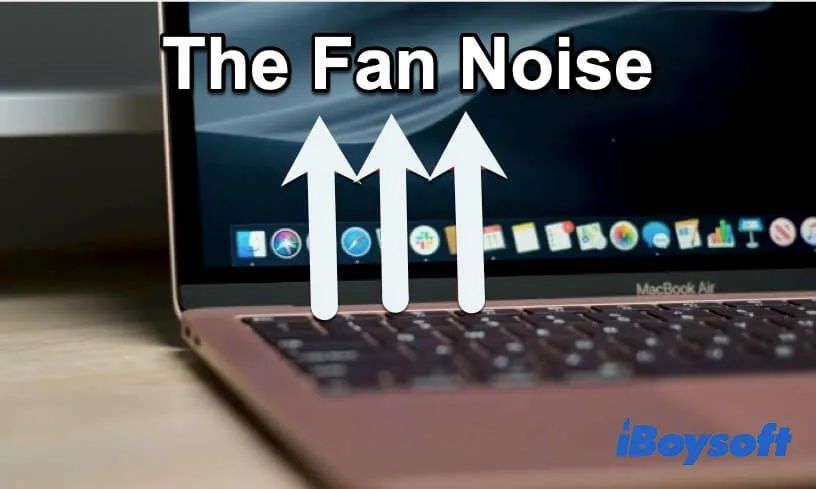A loud or constantly spinning MacBook fan can be annoying, but it’s usually nothing to worry about. The fan noise indicates that your Mac is working hard and keeping itself cool. However, in some cases, loud fan noise may signal a problem that requires attention.
Why is my MacBook fan so loud?
There are a few common reasons why your MacBook’s fan may be running at higher speeds and making more noise:
- Processor-intensive tasks: Activities like gaming, video editing, streaming, and running multiple resource-heavy apps can ramp up processor usage and heat, triggering louder fan noise.
- Overheating: Dust buildup in air vents or lap usage can restrict airflow and cause overheating, which the fan works harder to counteract.
- Older MacBook model: Some older MacBooks had noisier, less efficient fans than newer models.
- Background processes: Apps running tasks in the background can gradually heat up your system over time.
- Firmware bugs: Rarely, fan control firmware bugs may cause abnormal fan behavior.
When is loud fan noise a problem?
While loud fan noise is usually benign, there are some circumstances where it can indicate an issue that needs troubleshooting:
- Fan constantly running at high speed: If your Mac’s fans are persistently revved up even when you’re not running intensive tasks, it likely indicates overheating.
- Loud grinding or buzzing: Unusual grinding, rattling, or buzzing fan noises may signal a mechanical breakdown.
- Heat despite loud fan: If your Mac feels hot despite fan noise, this points to ineffective cooling.
- Loud fan during light use: Fan noise when just using email, web browsing, etc. often means there’s a runaway background process.
- Abnormal pulsating noise: Irregular pulsing fan noises could mean a fan is partially obstructed or failing.
How to diagnose the cause of loud MacBook fan noise
If your MacBook’s loud fan is persistently bothering you, run through these troubleshooting steps to diagnose and fix the problem:
1. Listen for abnormal fan noises
Try to pinpoint the character of the fan noise. As mentioned above, buzzing, grinding, rattling noises may indicate a fan hardware problem. Intermittent pulsing noises could mean obstruction. High-pitched whining can signal dust buildup.
2. Monitor activity monitor
Open Activity Monitor in the Utilities folder and check the CPU tab. If any apps show high usage percentages, they may be causally linked to loud fan noise.
| App Name | CPU Usage |
|---|---|
| Microsoft Word | 75% |
| Google Chrome | 60% |
| Preview | 30% |
3. Reboot and listen for changes
Reboot your MacBook and see if the fans remain loud right away. If they eventually ramp up over time, a background process may be to blame.
4. Check for overheating
Use a temperature monitoring app to check component temperatures. Consistently high temps above 200°F/90°C indicate overheating.
5. Update macOS and apps
Make sure your system and apps are updated. Outdated software can cause compatibility issues leading to loud fan noise.
6. Try an SMC reset
Reset the System Management Controller to clear any potential corrupt power and thermal data making fans overwork.
7. Clean dust from vents
Use compressed air to flush out any dust restricting airflow through the heat sinks and ventilation openings.
8. Limit processor-intensive apps
Avoid running many demanding, hot-running apps simultaneously to reduce thermal strain on your hardware.
9. Adjust user settings
Lower processor clock speeds, dim screen brightness, close unneeded apps, and avoid lap usage to run cooler.
When to take your MacBook in for fan noise repair
If you thoroughly troubleshoot and loud fan noise persists, or you detect abnormal grinding/buzzing, it’s time to seek professional help. An Apple technician can diagnose hardware issues like failing fans and recommend solutions like a fan replacement.
A loud MacBook fan can also indicate clogged heat sinks or a misapplied thermal paste replacement. An expert can safely open up your Mac, thoroughly clean the fans and internals, and ensure proper thermal paste application.
DIY remedies to quiet a noisy MacBook fan
Before resorting to a repair shop, you can attempt some DIY fixes to quiet a loud MacBook fan:
- Reset SMC and PRAM: This can clear up firmware issues causing fan abnormalities.
- Clean dust: Use compressed air to clean dust clogging fan blades and internal vents.
- Replace thermal paste: New thermal paste can improve heat transfer from components to heatsinks.
- Adjust fan speeds: Utilities like Macs Fan Control let you adjust fan speeds.
- Create a spacers: Small rubber feet or spacers can improve airflow underneath a hot-running MacBook.
However, these are temporary band-aid solutions if there is an underlying hardware problem. Professional repair is recommended for any persistent fan abnormalities.
Best practices to prevent loud MacBook fans
You can take proactive steps to promote quiet, efficient fan operation in your MacBook:
- Clean dust regularly from external vents and heatsinks using compressed air.
- Update to the latest macOS version for optimal system management.
- Avoid using your MacBook on soft surfaces that can block airflow.
- Manage your workload to avoid overtaxing the CPU with demanding apps.
- Use activity monitor to quit any unnecessary apps hogging processor resources.
- Maintain ample space around ventilation openings when using your MacBook.
- Run CPU-intensive tasks while your MacBook is elevated on a hard surface.
- Using a laptop cooling pad can also help direct more airflow.
Conclusion
It’s normal for your MacBook’s fans to ramp up speed and noise when internal temperatures rise during strenuous tasks. But loud fan noise at other times can signal potential overheating problems or hardware faults needing attention.
Try troubleshooting steps like monitoring CPU usage, rebooting, cleaning vents, and software updates to identify and fix the cause. Persistent loud or abnormal fan noises after troubleshooting likely require professional MacBook fan repairs for long-term solutions.
With proactive maintenance and workload management, you can minimize disruptive fan noise and keep your MacBook running optimally for years before a fan replacement is needed.
